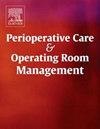Identifying factors associated with prolonged mechanical ventilation following isolated coronary artery bypass grafting: a retrospective observational study
IF 1
Q2 Nursing
Perioperative Care and Operating Room Management
Pub Date : 2025-09-30
DOI:10.1016/j.pcorm.2025.100565
引用次数: 0
Abstract
Background
The Society of Thoracic Surgeons has advocated for enhanced recovery after cardiac surgery and recommends extubation of patients within 6 h following routine coronary artery bypass grafting (CABG). Early extubation has been shown to decrease mortality and postoperative complications. The primary objective of this study was to create a preliminary prediction model that would identify modifiable factors associated with prolonged postoperative mechanical ventilation following isolated CABG at our institution.
Methods
This was a single-center retrospective observational records review study. Case records for 85 patients who had undergone an isolated, elective CABG between January 2021 and December 2022 were evaluated. A multivariable logistic regression model with backwards selection was used to estimate probability of prolonged postoperative mechanical ventilation (>6 h). Predictor variables were based on readily available clinical information on patient demographics, comorbidities, and factors related to operative management (time on bypass, opioid use, patient acid-base status, core temperature). Models were internally validated by bootstrapping, and model performance was evaluated by optimism-corrected c-statistics.
Results
Twenty-six of 85 patients (31 %) were intubated for >6 h. Base deficit, age, core temperature, and history of chronic obstructive pulmonary disease (COPD) were the strongest and most consistent predictors of prolonged intubation. Model discrimination and calibration were satisfactory (c-statistics > 0.75). A simple probability chart was constructed from the final model to estimate patient risk of prolonged intubation.
Conclusions
Older (>75 years), increased base deficit (base deficit ≤ -6 mmol/L), and hypothermic (<36 °C) patients with history of COPD had the highest estimated probability of prolonged intubation (>90 %) following isolated CABG. Future validation studies will require a larger cohort. Nevertheless, findings from this study have led to proactive changes in patient management at our institution to identify high-risk patients and prevent or partially reverse base deficit and hypothermia before patient arrival to the intensive care unit.
确定孤立冠状动脉旁路移植术后延长机械通气的相关因素:一项回顾性观察研究
背景:胸外科学会提倡提高心脏手术后的恢复,并建议患者在常规冠状动脉旁路移植术(CABG)后6小时内拔管。早期拔管已被证明可以降低死亡率和术后并发症。本研究的主要目的是建立一个初步的预测模型,以确定与我院孤立性冠状动脉搭桥术后延长机械通气相关的可修改因素。方法采用单中心回顾性观察性研究。评估了2021年1月至2022年12月期间接受孤立、选择性冠脉搭桥的85例患者的病例记录。采用反向选择的多变量logistic回归模型估计术后延长机械通气(>6 h)的概率。预测变量基于易于获得的临床信息,包括患者人口统计学、合并症和与手术管理相关的因素(搭桥时间、阿片类药物使用、患者酸碱状态、核心温度)。模型通过bootstrapping进行内部验证,模型性能通过乐观校正的c-statistics进行评估。结果85例患者中有26例(31%)插管时间为6小时。基础缺陷、年龄、核心温度和慢性阻塞性肺疾病(COPD)史是延长插管时间的最强和最一致的预测因素。模型判别和校正均令人满意(c-statistics > 0.75)。根据最终模型构建一个简单的概率图来估计患者延长插管的风险。结论老年患者(75岁)、基础缺损增加(基础缺损≤-6 mmol/L)和低温(36°C)有COPD病史的患者在孤立性冠脉搭桥后延长插管的估计概率最高(90%)。未来的验证研究将需要更大的队列。尽管如此,这项研究的结果导致我们机构在患者管理方面进行了积极的改变,以识别高危患者,并在患者到达重症监护室之前预防或部分逆转基础缺陷和体温过低。
本文章由计算机程序翻译,如有差异,请以英文原文为准。
求助全文
约1分钟内获得全文
求助全文
来源期刊

Perioperative Care and Operating Room Management
Nursing-Medical and Surgical Nursing
CiteScore
1.30
自引率
0.00%
发文量
52
审稿时长
56 days
期刊介绍:
The objective of this new online journal is to serve as a multidisciplinary, peer-reviewed source of information related to the administrative, economic, operational, safety, and quality aspects of the ambulatory and in-patient operating room and interventional procedural processes. The journal will provide high-quality information and research findings on operational and system-based approaches to ensure safe, coordinated, and high-value periprocedural care. With the current focus on value in health care it is essential that there is a venue for researchers to publish articles on quality improvement process initiatives, process flow modeling, information management, efficient design, cost improvement, use of novel technologies, and management.
 求助内容:
求助内容: 应助结果提醒方式:
应助结果提醒方式:


